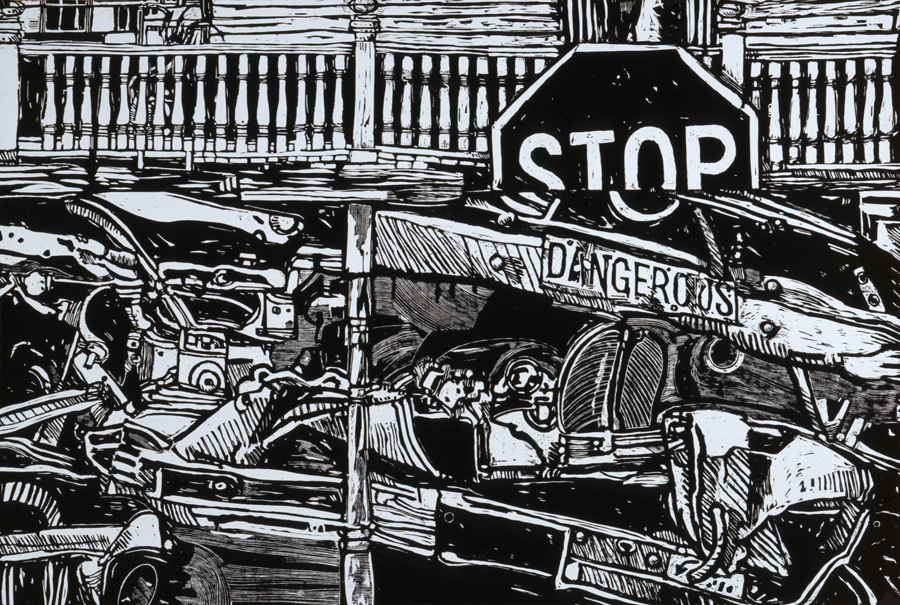via Louisiana Cultural Vistas, Ogden Museum of Southern Art, Winter 2017

John T. Scott, Blues Poem for the Urban Landscape: Dangerous, 2002-2003, woodcut
Prospect 4 Spotlights John T. Scott
As part of Prospect.4: The Lotus in Spite of the Swamp opening November 16-18, the Ogden Museum of Southern Art will exhibit nine prints and an original woodcut block from John T. Scott’s 2003 series, Blues Poem for the Urban Landscape. Inspired by the urban decay found in many cities throughout the US, these surreal scenes of society’s detritus piled around and upon the historic and vernacular architecture of New Orleans took on new meaning after 2005. The world Scott created through these chainsaw-carved blocks seemed to be prescient artistic vision in the wake of Hurricane Katrina, as his imagined chaos became a reality in the New Orleans cityscape. In today’s environment of revitalization and gentrification, Scott’s series stands as testament to that tragic moment, and to the resilience of the culture and people of South Louisiana. Like all of Scott’s work, these prints stand as powerful objects unto themselves. Separated from narrative and historical context, they are still skillfully executed prints that blur the line between figuration and abstraction.
In the 40-plus years that John T. Scott worked as an artist an educator in New Orleans, his intuitive process pushed his work in many directions. He was a master of both abstraction and figuration, and moved fluidly between sculpture, painting, printmaking or drawing. He developed a visual language that was uniquely his own – deeply rooted in place, with a process driven by the improvisational concepts of Jazz, and informed by the African, Caribbean and European amalgam of New Orleans.
On September 30, 2017, the Ogden Museum of Southern Art opened Solidary & Solitary: The Joyner/Giuffrida Collection, Presented by The Helis Foundation. This exhibition showcases some of the strongest African-American voices in art from 1940 to the present. In conjunction with this exhibition, the museum is presenting three works from its permanent collection by John T. Scott in the atrium of Goldring Hall. These sculptural works are from two earlier series by Scott, and show the wide range of his vision and style. Butterfly Pin Up and Ritual Cutter (No.2) are from a 1978 series of delicately painted bentwood works, and act as both minimalist sculpture and ritual objects used to cut through the barriers of social injustice. Flags (ca. 1997) is a kinetic sculpture inspired by the West African story of the “diddly bow,” an object of war turned into an object honor and reconciliation. These works show Scott as an artist whose production was equally involved in a contemporary art dialogue and the social concerns of his city and culture. Placed in context with works by the artists in Solidary and Solitary – from pioneering visionaries like Norman Lewis to contemporary masters like Mark Bradford – these pieces situate John T. Scott as an important figure in the history of American Art.
ABOUT THE ARTIST
John T. Scott was born in New Orleans in 1940. He received a B.A. from Xavier University of Louisiana in 1962 and an M.F.A. from Michigan State University in 1965. It was at Michigan State that he gained two important assistantships with his major professors, sculptor Robert Weil and painter/printmaker Charles Pollock. He received an honorary Doctor of Humanities from Michigan State University in 1995 and a Doctor of Humanities from Tulane University in 1997. He was Professor of Fine Arts at Xavier University for more than forty years. In 1983, he received a grant to study under internationally renowned sculptor George Rickey. In 1992, he was awarded a “Genius Grant” from the John D. and Catherine T. MacArthur Foundation. His work has been featured in numerous exhibitions at galleries and institutions, including the Contemporary Arts Center in New Orleans, LA; the Studio Museum in Harlem, NY; the Smithsonian American Art Museum, Washington, D.C.; the American Jazz Museum, Kansas City, MO; the SculptureCenter, Long Island City, NY; the Boston Center for the Arts, Boston, MA and the Tubman Museum in Macon, GA. His many public art commissions can be viewed throughout the city of New Orleans, including Spiritgates, which adorn a courtyard entrance at the New Orleans Museum of Art, the Spirit House at DeSaix Circle, a collaboration with Martin Payton commemorating the history of African Americans in the city; and Ocean Song in Woldenberg Park, with elements that produce visual patterns reminiscent of jazz. In 2005, the New Orleans Museum of Art hosted a career retrospective Circle Dance: A John T. Scott Retrospective. Scott evacuated to Houston, TX following Hurricane Katrina. He died there in 2007.
Click here to listen to artist John Scott talk about his work in this interview, recorded by Fred Kasten for WWNO FM, New Orleans, ca. 1990s.